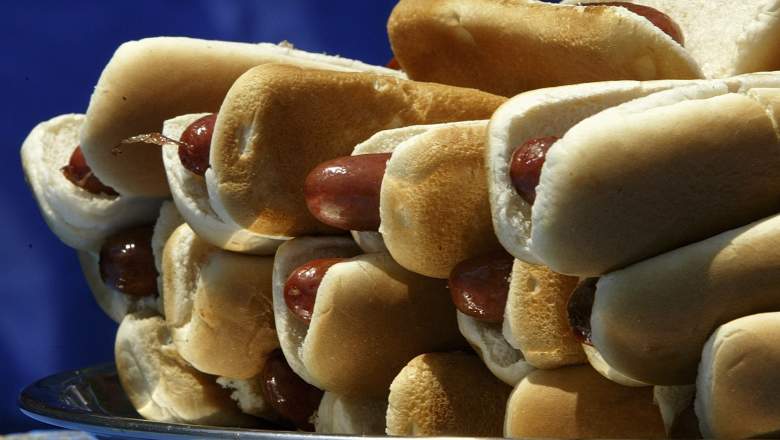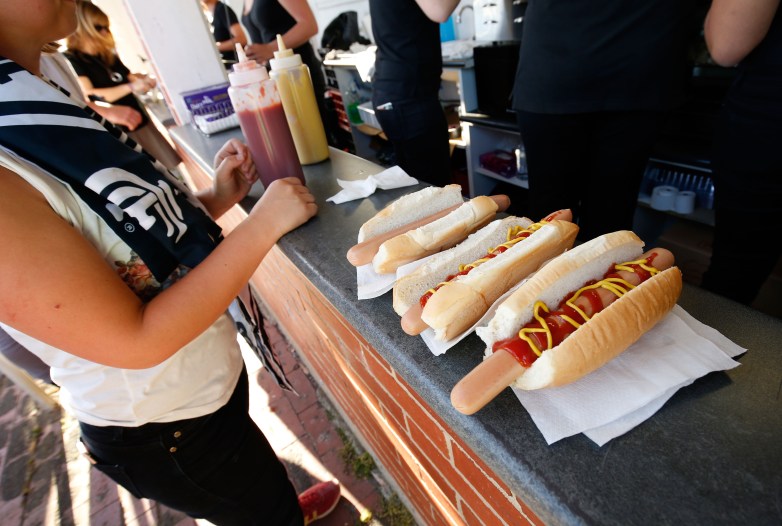
Getty Today marks National Hot Dog Day.
July 19 is National Hot Dog Day, although for many Americans, we hardly need a reason to eat a hot dog. It remains one of our most favorite foods and it’s the star of the most popular competitive eating contest on the planet. Plus, one of the most iconic vehicles we know is shaped like one!
Like most American foods, the hot dog is an immigrant. Sausages made of pork that are similar to what we eat today originated in Germany and German immigrants brought them over in the second half of the 19th century. Nathan Handwerker, a Polish immigrant, is credited with popularizing the hot dog in the U.S.
Here’s a look at the history of the hot dog and why we celebrate it today of all days.
1. National Hot Dog Day Was Founded by the American Meat Institute

GettyHungry yet?
National Hot Dog Day was created by the North American Meat Institute, an industry trade group. In 1994, NAMI founded the National Hot Dog and Sausage Council (NHDSC) as an “information resource to consumers and media on questions related to quality, safety, nutrition and preparation of hot dogs and sausages.”
The council picked the third Wednesday of July for the holiday to have it timed to NAMI’s Annual Hot Dog Lunch on Capitol Hill.
According to NAMI, the 2016 event featured seven vendors serving over 3,500 hot dogs and sausages to over 1,000 lawmakers and their staff. Meat industry lobbyists also attend the event.
“The Hot Dog Lunch has been an annual tradition for more than 40 years. This longstanding event celebrates America’s love of hot dogs—a love that crosses party lines,” NAMI President and CEO Barry Carpenter said after the 2015 event. “The lunch is one of the most popular and anticipated events on Capitol Hill, as guests join us to celebrate this iconic American food in the company of major league baseball greats.”
2. Americans Spent $2.4 Billion on Hot Dogs in 2016 at the Supermarket

GettyThere aren’t too many foods that get a vehicle shaped like them.
Americans love their hot dogs. According to the NHDSC, Americans spent $2.6 billion on hot dogs at supermarkets in 2016 alone.
The council reports that Americans eat 150 million hot dogs on Independence Day. Los Angeles residents eat an estimated 36 million pounds of hot dogs a year, more than New York and Philadelphia. However, the council says that travelers moving through O’Hare International Airport in Chicago eat six times as many hot dogs as travelers going through LAX and New York’s LaGuardia Airport combined.
Nielsen statistics show that the top 10 “hot dog consuming” cities are Los Angeles, New York, Philadelphia, Boston, Chicago, Atlanta, Detroit, Washington D.C. and Tampa. Baseball fans bought 19.4 million hot dogs during the 2016 MLB season.
Peak hot dog-eating season is between Memorial Day and Labor Day. Nielsen estimates that 38 percent of all hot dogs sold in a year are bought during this period. Americans consume 7 billion hot dogs during the “hot dog season,” or about 818 hot dogs every second.
3. The Man Credited With Popularizing the Hot Dog in the U.S. Is Polish Immigrant Nathan Handwerker

GettyConey Island in 1976.
Like many popular foods, there are several stories about their creation. As History.com notes, the history of the sausage dates back to the Roman Empire. Over time, the sausage became a staple of the German diet and the city of Frankfurt claims to be the place where the hot dog we know today was created in 1484.
Then again, Vienna, Austria also lays claims to it, as the term “weiner” is a reference to the German name of the city, “Wein.” In addition, Germans call the beef/pork mix sausage “Wiener Würstchen,” while the pork-only sausage is called a Frankfurter.
However, the man credited with making the hot dog popular in the U.S. wasn’t German. He was Nathan Handwerker, the founder of the legendary Coney Island hot dog stand that became Nathan’s Famous. In 1915, he was working at a hot dog stand owned by another businessman who charged 10 cents for a hot dog. He saved up $300, then opened his own stand and hold hot dogs for half the price. His business boomed and his old boss was out of business.
During the Great Depression, the popularity of hot dogs skyrocketed for the same reason we eat them today – they’re cheap. By the late 1930s, hot dogs had become such a famous part of American culture that First Lady Eleanor Roosevelt served them to King George VI of England in 1939.
4. Mustard Is the Most Popular Hot Dog Topping

GettyMustard, Ketchup or both?
You can put whatever you want on hot dogs, but many Americans prefer mustard. In a 2014 survey, the NHDSC found that 71 percent of Americans top their dogs with mustard. The poll, conducted by Harris Poll, found that 52 percent of Americans use ketchup, while 47 percent also use onions. Forty-five percent like chili as a hot dog topping, while 41 percent use relish.
“Our mustard finding is no surprise given the condiment’s prominent place on regional favorites like New York and Chicago Dogs,” NHDSC President and Queen of Wien Janet Riley said in 2014. “Ketchup’s popularity was the big surprise, considering our etiquette rules – and ketchup’s notable absence from regional hot dog favorites like the Chicago Dog and the New York Dog. The high scores for so many condiment options suggest that Americans may be topping their hot dogs more generously than ever.”
When broken down by regions, those in the Northeast love sauerkraut, while Midwesterners are more likely to use ketchup. In the West, people love adding jalapenos, while Southerners love chili, cheese and coleslaw.
The poll also found that 71 percent of Americans think ketchup is an acceptable hot dog topping.
5. Several Restaurants Across the Country Have Hot Dog Deals for the Holiday
Like many other food holidays, National Hot Dog Day also gets its fair share of deals.
Since July is also National Hot Dog Month, Burger King has been selling hot dogs for 79 cents. Dog Haus locations are giving away a free dog with the purchase of a full-priced hot dog.
At Sonic Drive-In restaurants, you can get their hot dogs for $1. If you print out this coupon and bring it to a Love’s Travel Shop, you get a free hot dog.
